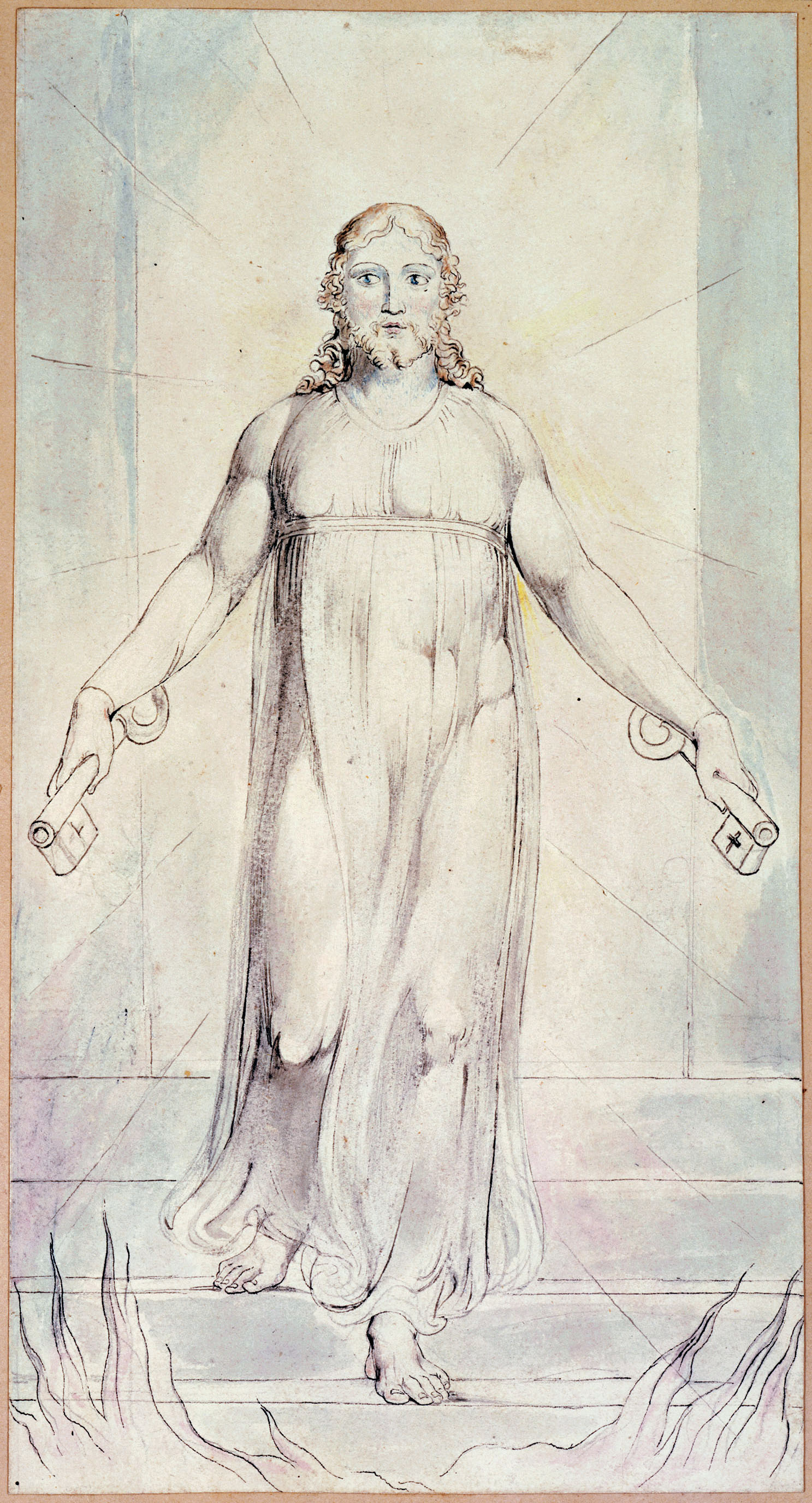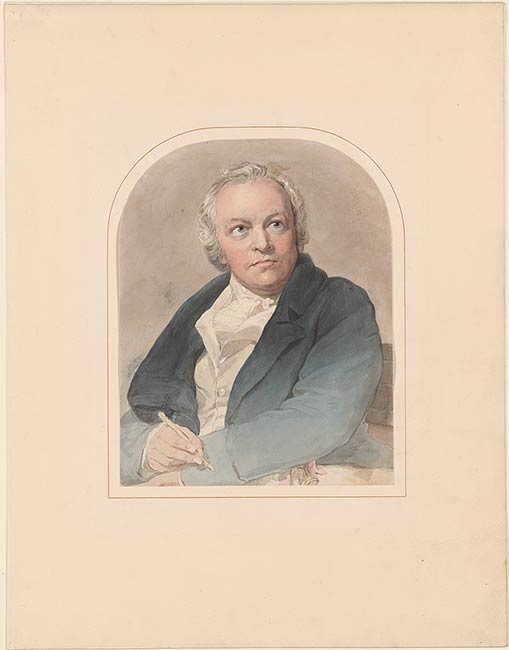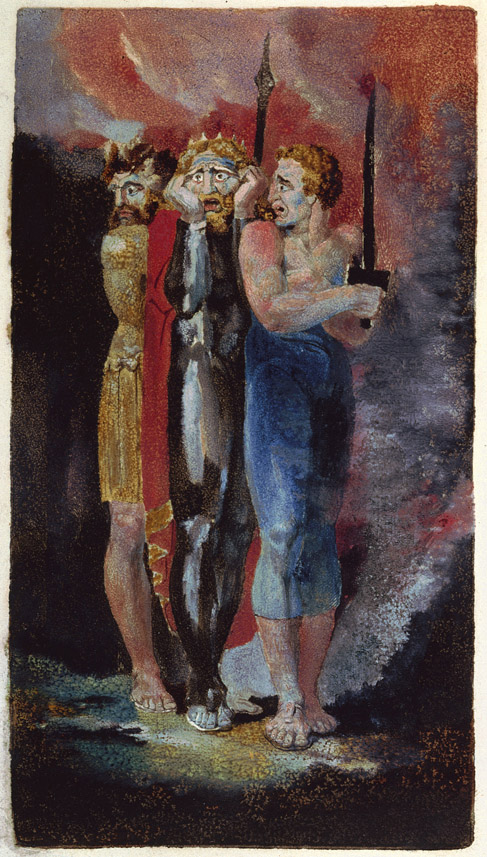 |
| The Grave - Page 3 Fuseli's arrangement Blake's Watercolor |
 |
| British Museum The Grave - Page 3 Cromak's arrangement Schiavonetti's Engraving |
III. DEATH'S DOOR.
For himself and for his audience Blake longs for the passage
through Eternal Death and awakening to Eternal Life. His view is
that if man voluntarily enters the Door of Death, he embarks on the journey which leads to Eternal Life. There is a
Golden String which man may follow through the labyrinth of
existence. The preparation for undertaking the journey through the
grave is awareness of the 'Immortal Man that cannot Die.
When we think metaphorically, death in the physical world
connotes entry into the unknown void. But life beyond physical
death is no more of a mystery than life in the physical world. The
'events' of one's life are pointers to, or tracings of, what is
experienced in another realm. If life were just the passage from
material birth to material death it would easily be discarded, but we cling to it
tenaciously because it contains more than is revealed externally.
When we are aware that we have received life as a gift, we have
the responsibility to live purposefully. So death is a metaphor
for relinquishing the known, just as life is a metaphor for
affirming the unknown.
If one enters the Door of Death one assumes the responsibility of
looking within, of exploring the recesses of the grave for the
purpose of discerning what cannot be learned in the outer world.
Jerusalem, Plate 1, (E 144)
"There is a Void, outside of Existence, which if enterd into
Englobes itself & becomes a Womb, such was Albions Couch
A pleasant Shadow of Repose calld Albions lovely Land
His Sublime & Pathos become Two Rocks fixd in the Earth
His Reason his Spectrous Power, covers them above
Jerusalem his Emanation is a Stone laying beneath
O [Albion behold Pitying] behold the Vision of Albion"
Jerusalem, Plate 4, (E 146)
"Of the Sleep of Ulro! and of the passage through
Eternal Death! and of the awaking to Eternal Life.
This theme calls me in sleep night after night, & ev'ry morn
Awakes me at sun-rise, then I see the Saviour over me
Spreading his beams of love, & dictating the words of this mild song."
THE GATES of PARADISE For The Sexes, (E 269)
Keys
"13 But when once I did descry
The Immortal Man that cannot Die
14 Thro evening shades I haste away
To close the Labours of my Day
15 The Door of Death I open found
And the Worm Weaving in the Ground"
Dedication to Blake's Illustrations to Blair's Grave, (E 480)
"TO THE QUEEN
The Door of Death is made of Gold,
That Mortal Eyes cannot behold;
But, when the Mortal Eyes are clos'd,
And cold and pale the Limbs repos'd,
The Soul awakes; and, wond'ring, sees
In her mild Hand the golden Keys:
The Grave is Heaven's golden Gate,
And rich and poor around it wait;
O Shepherdess of England's Fold,
Behold this Gate of Pearl and Gold!
To dedicate to England's Queen
The Visions that my Soul has seen,
And, by Her kind permission, bring
What I have borne on solemn Wing,
From the vast regions of the Grave,
Before Her Throne my Wings I wave;
Bowing before my Sov'reign's Feet,
"The Grave produc'd these Blossoms sweet
"In mild repose from Earthly strife;
"The Blossoms of Eternal Life!
WILLIAM BLAKE"
Milton, Plate 32 [35], (E 132)
"Judge then of thy Own Self: thy Eternal Lineaments explore
What is Eternal & what Changeable? & what Annihilable!
The Imagination is not a State: it is the Human Existence itself
Affection or Love becomes a State, when divided from Imagination
The Memory is a State always, & the Reason is a State
Created to be Annihilated & a new Ratio Created
Whatever can be Created can be Annihilated Forms cannot
The Oak is cut down by the Ax, the Lamb falls by the Knife
But their Forms Eternal Exist, For-ever. Amen Halle[l]ujah
Thus they converse with the Dead watching round the Couch of Death.
For God himself enters Death's Door always with those that enter
And lays down in the Grave with them, in Visions of Eternity
Till they awake & see Jesus & the Linen Clothes lying
That the Females had Woven for them, & the Gates of their Fathers House"
.










